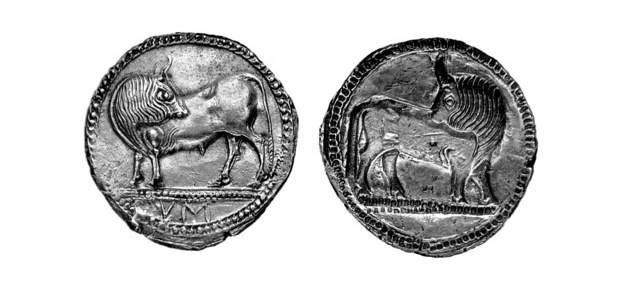
3.2 Sybaris
Sybaris was the oldest and most famous Peloponnesian colony of Magna Grecia. Strabo says that Sybaris was founded by the Achaeans the crater between the river and the river Sybaris (today called Coscile), and that his ecista (head of the colonial expedition) Is was one of Elice. On the foundation of Sybaris we have little information but that the city was of Achaean origin is confirmed by various parties. In a passage of Livy states that the Turi, Livy evidently considers that the successors of the Sybarites, were relatives of Metapontines and how they came from Achaia. For the blood ties that bound to Croton and Sybaris Metapontines, it also alludes to the story that Justin is the destruction of Siri. The founders of Sybaris were therefore considered as originating in that region of the Peloponnese which overlooked the Gulf of Corinth and that until the age classical retained the old name of Achaia. According to Strabo Elice was home dell'ecista Is, the name of which, perhaps, there has been passed correctly. According to Strabo, a source that flowed near Bura in Achaia, you just called Sybaris, that had the same name who had the Italiot city and one of its two rivers, what was called Sybaris and is now called Coscile; e other Fiume, the crater (Crathis), owed its name to the river that flowed near Ege in Achaia, and it was so named because its waters mingled with those of two tributaries.
But the Achaeans were not the only ones to colonize Sybaris, as shown by a passage of Aristotle, of which you have no reason to doubt. The Achaeans, according to Aristotle, coexisted at Sybaris with Trezeni, but then took advantage of their numerical superiority to drive them. This deed the Sybarites had to expiate. The Trezeni of Sybaris were forced to go to found a new city, Posidonia. Diodorus informs us that Sybaris became the largest town in Italy because it easily granted citizenship to foreigners. Nor is it conceivable that the Sybarites have admitted in their city a number of indigenous people in the area, after being Hellenized. Eusebius places the foundation of Sybaris to the 709 a.C. The city would have about 210 years of life florida, then be destroyed in 510 a.C. Sybaris, it is said, the crater was built between the river and the river Sybaris (Today Coscile), that once they had two distinct foci and that their courses were merged when the Crotonians diverted the waters of the crater on the ruins of the destroyed city. Sybaris did not have a port for the whole coast is fringed by a band of shallow sandy. However, the mouth of the two rivers, whose regime was more regular than today, should be accessible to ancient ships. For against, the vast plain that the Sybarites ruled from their city, that stood in the middle, fertility was celebrated by all the ancient authors. In plain cultivated wheat and mountain slopes are cultivated grapevines and olive. And this was added to the timber and the pitch of the great forests that once covered, and in good part cover still, the Sila plateau. The subsoil, rich silver mines, was instrumental in enriching the city.




